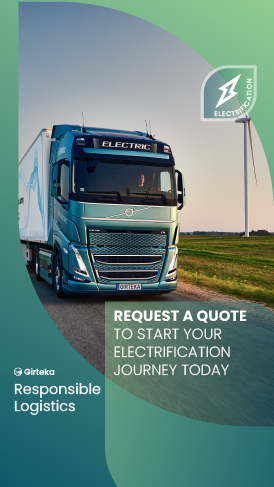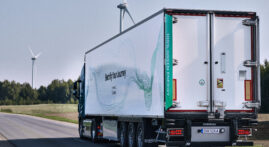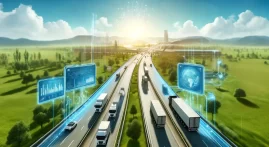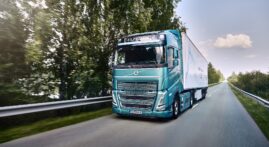Ignoring the technological developments that improved the ruggedness, reliability, and speed of supply chains would be extremely difficult, especially when one is working in the road freight transport industry. After all, progressive technologies, whether it would be such rudimentary things as a digital tachograph, a Digital Mobile Radio (DMR), or more advanced items inside the cabin of a truck like digital side mirrors have to be adopted and actively used by someone for them to actually make an impact. Additionally, various technological advancements have to be tested and improved continuously to ensure that the development of an exemplary item does not stop and that users, whether businesses or regular consumers, could continue using the best version of the device or software daily.
Nevertheless, a more digital road freight transport sector in Europe is beneficial for both shippers and carriers, whichever way you look at it. A more efficient industry that carries household and crucial items between borders also means that customers will be happier with faster and more environmentally-friendly deliveries.
Internet of things (IoT) and logistics
While the Internet of Things (IoT) can appear as another buzzword-like phrase just to attract a crowd that is interested in technology, the importance of the description of physical objects will only continue to grow as we continue moving forward technologically. For one, the very definition of IoT, per the Cambridge Dictionary, is that it describes “objects with computing devices in them that are able to connect to each other and exchange data using the internet.” As a result, with more onboard computers present on trucks, and supply chains being managed more digitally, the more inter-connected supply chains will become.
Yet that was not always the case, as we can probably imagine the chaos that surrounded the numerous sheets of paper in the older days when managers had to manually track movements and the loading/unloading destinations. One can imagine that supply chains could extend for thousands of kilometers as they do today, and they would be concentrated more locally just so that the complexity would not get out of hand. Whatever the case might have been in the old days, today, supply chains can extend for those very same thousands of kilometers across borders and even continents, as various Transport Management Systems (TMS) and Fleet Management Systems (FMS) can assure the safety and reliability of transportation. Even the advancement of basic navigational systems played a huge part in allowing trucks to travel to previously unexplored regions, enabling international trade like never before.
And such systems as the TMS and FMS can be viewed as being part of the IoT. For one, if a transport manager can see how many hours a driver has actively driven their truck, it is much easier to plan their journeys for the week ahead, including when they will need to take their 45-hour weekly rest. Secondly, you can also plan around mandatory technical vehicle inspections and tire or oil changes with an FMS, while a TMS allows an organization to properly manage and assign customers’ loads accordingly. While it is a very basic rundown of how IoT can play into the hands of the logistics industry that is trying to digitalize its processes from top to bottom.
Why digitalize logistics?
Asking yourself or a fellow industry representative why should digitalization be present in the logistics sector is a valid line of thought. After all, doing something just because of a habit of seeing your food being delivered is not a valid reason to implement real-time visibility for a carrier, considering the volume of investment into the facilities and trucks required to actually have it working perfectly.
But there are good reasons why digitalization has been and needs to continue seeping into the road freight transport industry’s processes.
“Digitalization, including automation, digitized information flows, and artificial intelligence (AI), provides many opportunities to improve efficiency, reduce costs, and increase service levels in the road freight transport sector,” noted one study by four scholars at the Stockholm School of Economics and published in 2021, which looked into how digitalization will affect road freight transport. While the authors pointed out that digitalization will enable the development of new services and products in the industry, which will increase vehicle kilometers traveled (VKT), the tendency for companies to automate and move towards digital processes is “expected to contribute to reductions in VKT by providing opportunities to set and monitor new regulations, such as kilometer-based taxes, and by increasing fill rates through data sharing and by connecting goods (Internet of Things).”
Furthermore, route planning and optimization of operations and storage of goods on trailers should see efficiency gains as carriers integrate technology-based solutions into their offerings. Much like any other transport sector, the road freight transport industry is under a magnifying glass to reduce its emissions, as the European Union (EU) and lawmakers in other jurisdictions are pressing on with their goals to reduce the overall emissions. Still, the technology of zero-emission trucks is still in its infancy, as only recently Volvo announced that it is supplying 20 heavy-duty trucks to one of the largest e-commerce companies for its Germany-based operations. Even if a small start, it is a start nevertheless.
Benefiting shippers and customers
Focusing on achieving more efficiency is not a bad idea when thinking about the benefits of digitalization, yet perhaps gaining more operational efficiency is something that is always at the back of the logistics executives’ minds. Optimization of costs is nothing new in road freight transport or business in general, as having the ability to control expenses can be the foundation on which one can build the long-term future of one’s company.
Yet digitalization can do much more than optimize costs. Reducing the amount of human error can be cited as one example, as so can the speed of transportation, as well as monitoring and sharing important data between a carrier and shipper. Being more sustainable can also be achieved with digitalization, even if it does not mean integrating electric or hydrogen-powered trucks into transportation processes.
At the basis of it, though, is data. Without knowing how to manage, share, and utilize data from daily operations, the house of cards falls apart quite quickly and any investments in digitalization can go to waste. On the other hand, if a company manages to ensure a steady and reliable stream of data throughout its operations, whether it would be trucks on the road or journey planning, it can result in greatly improved road freight transport services. For one, customers would be able to enjoy knowing when exactly their shipment will arrive, which in turn, would allow them to plan around that time and deploy resources accordingly.
That is one of the benefits of real-time visibility (RTV), especially if a solution from a carrier is easily included in a shipper’s supply chain management solution. Girteka, which launched its RTV solution in February 2022, has seen success with its customers utilizing the transparency of their supply chains to benefit their own operations, for example.
“With our real-time visibility solution, we aim to provide transparent and open transport services to our customers, no matter how small or large our partnership is with them,” commented Pavel Kveten, the Chief Operating Officer (COO) of Girteka Europe West at the time of the launch of Girteka’s RTV solution.
Automatization of processes is also something that the company has been looking into. One example could be the implementation of automatization to abide by the rules set out by the Mobility Package, which requires trucks and drivers to return to either the home country or the base of operations following a certain period of time on the road.
“For example, in our transport department, we have a robotics process automation (RPA) solution that covers the requirements implemented by the mobility package. In six months, it has already covered more than 500,000 cases,” Giedrė Petrauskienė, Automation Service Lead at Girteka, shared her experience in October 2022. Automation is present elsewhere at the company, as loads, routes, and trucks are assigned with the help of Artificial Intelligence and SAP’s Transport Management (TM) solutions, automating some of the most crucial processes in logistics.
No other option than digitalization
Still, companies have ways to go before they are fully digitalized. The process is not as easy as it might seem from the outside, as data integrity is the key that unlocks many doors once digitalization is green-lit within a company. Whichever stage of digitalization the road freight transport industry is currently at, it is hard to deny that the future is digital.
The same connectivity as defined by IoT will be crucial to make sure that autonomous trucks, which are poised to come sooner rather than later will be integrated into the road systems across the continent. While it is no easy feat, as automakers for years have struggled to introduce a fully self-driving vehicle on the roads due to numerous software-related and legislative snafus, it is a future that many have placed their bets on.
Even then, before we see autonomous trucks on the road, digitalization and IoT will play a crucial part in the theater of logistics across continents in the coming years. Transparent and visible supply chains, as well as tailored solutions enabled by digitalization, will become the norm, as naturally, shippers begin discovering the benefits of having a digitally-advanced carrier responsible for the transportation of their goods. The pandemic was also an accelerator for the demand for more transparent supply chains, as uncertainty had to be quashed down with reliability and knowing how to plan around many of the restrictions that were placed at the time.
All in all, digitalization, much like sustainability, will become an ever-more important topic to be discussed by everyone who is involved in the road freight transport industry going forward. Whether it would be cost optimization, providing fully-tailored transport solutions, or transparent supply chains, carriers and shippers will have to stay on top of the latest trends in digitalization in order to not fall behind their competitors and the general direction the sector is going in.





